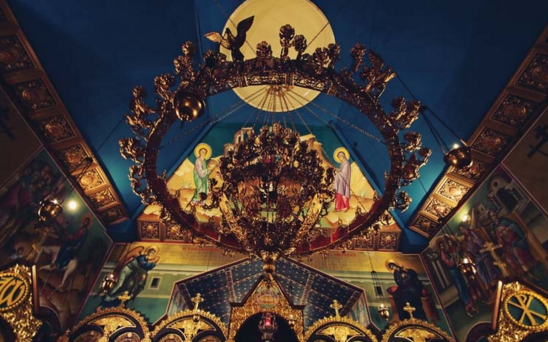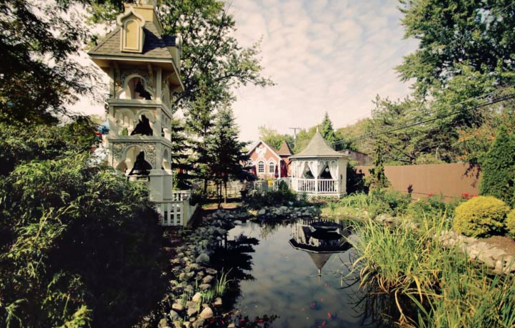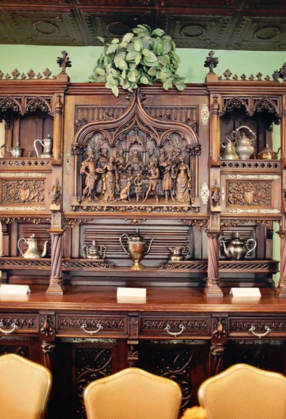
Crossing through the wrought-iron gate into the grounds of St. Sabbas Orthodox Monastery feels, in many ways, tantamount to stepping into another world.
It’s not just because the monastery’s Russian architecture — replete with towering onion domes, colorful mosaics, and other religious iconography — stands in contrast to its quiet, residential surroundings of Harper Woods, located on the outskirts of Detroit’s east side. And it’s not just the fact that metro Detroit is better known for its Roman Catholic heritage. (For the uninitiated, the Roman Catholic Church and the Orthodox Church were once one and the same, but parted ways as the result of a schism that was made official in 1054, during the days of the Byzantine Empire.)
The reason St. Sabbas feels like another world is by design. As numerous St. Sabbas congregants explain, Christian monks were fond of cultivating lush courtyards in their monasteries as an attempt to recreate the paradise of the Garden of Eden. And while standing in the center of St. Sabbas — surrounded by flowing fountains, ringing bells, a koi pond, and flowers in full bloom — it’s easy to feel a world away from Detroit.
The sprawling grounds of St. Sabbas are the work of John Belkoff, known as Father Pachomy. The metro Detroit native describes himself as a world-traveling priest of 30 years as well as a liturgical artist.
And by any measure, St. Sabbas is a work of art.
“We try to keep from the street view still a bit of a residential look,” Belkoff says. “But then when you walk into the gate, you’re in a whole different kingdom itself.”
Belkoff founded the monastery in the wake of the All Saints Russian Orthodox Cathedral, a nearly 100- year-old church on Joseph Campau Avenue and Hendrie Street that fell into disrepair following decades of white flight. But after the fall of the USSR, metro Detroit saw an influx of Russian immigrants?—?and a renewed interest in Orthodox churches.
In the ’90s, Belkoff temporarily relocated the church to the neighboring city of Eastpointe. That’s when he got the idea to found a monastery instead.
Belkoff received the blessing of the national church’s bishop to create the Midwest’s first monastery, but it would be up to him to secure property and funding.
“You have to understand that Orthodoxy, from the beginning of Christianity — since the time of Emperor Constantine — has been an imperial church,” Belkoff says. “Orthodoxy became the imperial church under emperor Constantine, all the way down to the Russian Revolution in 1917. So the church was always funded by emperors. But then it finds itself in America — which is a democracy, with multiple ideas of what is Christianity, and various religious persuasions. It really made a difficult situation.”
Starting in 1999, the St. Sabbas congregants began to purchase residential homes one by one, remodeling them as local permits allowed. The resulting complex is a mix of old and new structures, in some cases utilizing just one existing wall in order to comply with the laws.

Today, the structures’ origins are nearly impossible to trace from just looking at them, such as the garage that has been transformed into the onsite Royal Eagle, a high-end restaurant that serves as a fundraising arm for the church (see story).
Just about every nook and cranny of the complex is adorned in detail, from the floor at the entrance (decorated with an intricate mosaic patterned after the original floor of Church of the Nativity basilica in Bethlehem), to authentic Gothic furniture. The site even has a reliquary, a room that houses bones and other remains of prominent saints.
“Some of the great saints of the church, parts of their bodies are in repose here?—?in Harper Woods, Michigan,” Belkoff says.

While a suburban monastery with a gourmet restaurant might seem like a strange arrangement, Belkoff explains it’s not exactly unprecedented. In Russia, Soviet authorities destroyed an inordinate number of churches following the Bolshevik Revolution, but after the fall of Communism, the Russian Orthodox began to rebuild its churches. In order to raise money, the Russian church turned to transforming buildings into hotels and other business ventures. “It’s not a strange phenomenon throughout the Christian world, and it has worked for the monastery,” he says. “It’s just enough as a charity to help us with the basic bills.”
Everything above and beyond that comes from St. Sabbas’ benefactors — which includes Little Caesars pizza chain moguls Mike and Marian Ilitch (both of Macedonian descent) — who have donated numerous treasures, including the church’s pulpit.
Despite its modest origins, Belkoff says the monastery has become a global destination, attracting nearly 6,000 visitors during the summer months, and guests hail from all over the world. “We’ve created a place of pilgrimage for not just Christians, but all people who are interested,” he says.
Source: http://www.hourdetroit.com/Hour-Detroit/April-2016/An-Unorthodox-Church/

